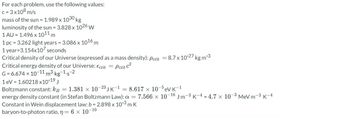Question

Transcribed Image Text:For each problem, use the following values:
c = 3x108 m/s
mass of the sun = 1.989 x 1030 kg
luminosity of the sun = 3.828 x 1026 W
1 AU = 1.496 x 1011 m
1 pc = 3.262 light years = 3.086 x 1016 m
1 year=3.154x107 seconds
Critical density of our Universe (expressed as a mass density): Pcrit =8.7 x 10-27 kg m-³
Critical energy density of our Universe: Ecrit = Pcrit c²
G=6.674 × 10-11 m³.kg-1.s-2
1 eV = 1.60218 x10-19.
Boltzmann constant: kg = 1.381 x 10-23 JK-18.617 × 10-5eV K-1
energy density constant (in Stefan Boltzmann Law): a = 7.566 x 10-16 Jm-3 K-4 -4.7 x 10-³ MeV m-3 K-4
Constant in Wein displacement law: b = 2.898 x 10-3 m K
baryon-to-photon ratio, n = 6 x 10-10

Transcribed Image Text:We observe a star that is dstar away. How much extinction would there need to be (i.e., what must 7 be) if we had ignored intervening dust, and concluded that it was actually 2*
dstar away?
Value:
dstar = 913 pc
Give your response to two decimal places.
Expert Solution
This question has been solved!
Explore an expertly crafted, step-by-step solution for a thorough understanding of key concepts.
This is a popular solution
Trending nowThis is a popular solution!
Step by stepSolved in 3 steps with 6 images

Knowledge Booster
Similar questions
- (Astronomy) Supernova Ejection Times. Observations show that the gas ejected from SN 1987A is moving at about 10,000 km⁄s. How long will it take to travel one astronomical unit in hours? (Note that 1 AU equals 1.5 × 108 km)arrow_forwardWe observe a star that is dstar away. How much extinction would there need to be (i.e., what must tau(τ) be) if we had ignored intervening dust, and concluded that it was actually 2*dstar away? Value: dstar = 850 pcarrow_forwardCluster Sizes. An open cluster is a collection of 10 to 1000 stars in a region about 25 pc in diameter. About how far apart are the stars in an open cluster in units of pc? (Hints: What share of the cluster's volume belongs to a single 4 Tr. Use the cited value for the maximum number of stars in your calculation.) star? The volume of a sphere is pc.arrow_forward
- What evidence is there that star formation has occurred recently?arrow_forwardPlanetary Nebula Age. Suppose a planetary nebula is 1 pc in radius. If the Doppler shifts in its spectrum show it is expanding at 20 km/s, how old is it? (Note that 1 pc equals 3.1x1013 km, and 1 year equals 3.2x107 seconds, to two significant figures.) Please round your answer to two significant digits. At = yearsarrow_forwardA) A typical dust grain has a radius of about 0.1 micrometers and a mass of 10-14 grams. Roughly how many dust particles are in a cloud containing 1000 Msun of dusty gas if 1% of the cloud's mass is in the form of dust grains? B) What surface area would be covered by these grains if you put them side by side? Assume these grains are spherical. Answer in square light-years. C) Estimate the total surface area covered by the cloud assuming it's matter density is like that of a typical molecular cloud, about 10-21 g/cm3 (Hint: first calculate the clouds volume from it's mass and density, then determine its radius using the formula for volume of a sphere) Answer in square light-years. D) Comparing all above answers, What are the chances (very roughly) that a photon passing through the cloud will hit a dust grain?arrow_forward
- How many years? Thank you!arrow_forwardDescribe the Nebular Theory. Include A) what it is, B)what happened, and C) at least three lines of evidence to support it.arrow_forwardFor the following light curve, which of the answers best illustrates the orientation of the exoplanet and its host star during the dip at Time 3? Light curve Time 1 Time 2 Time 3 Time 4 Choose one: А. O C. D. Intensity B.arrow_forward
arrow_back_ios
arrow_forward_ios